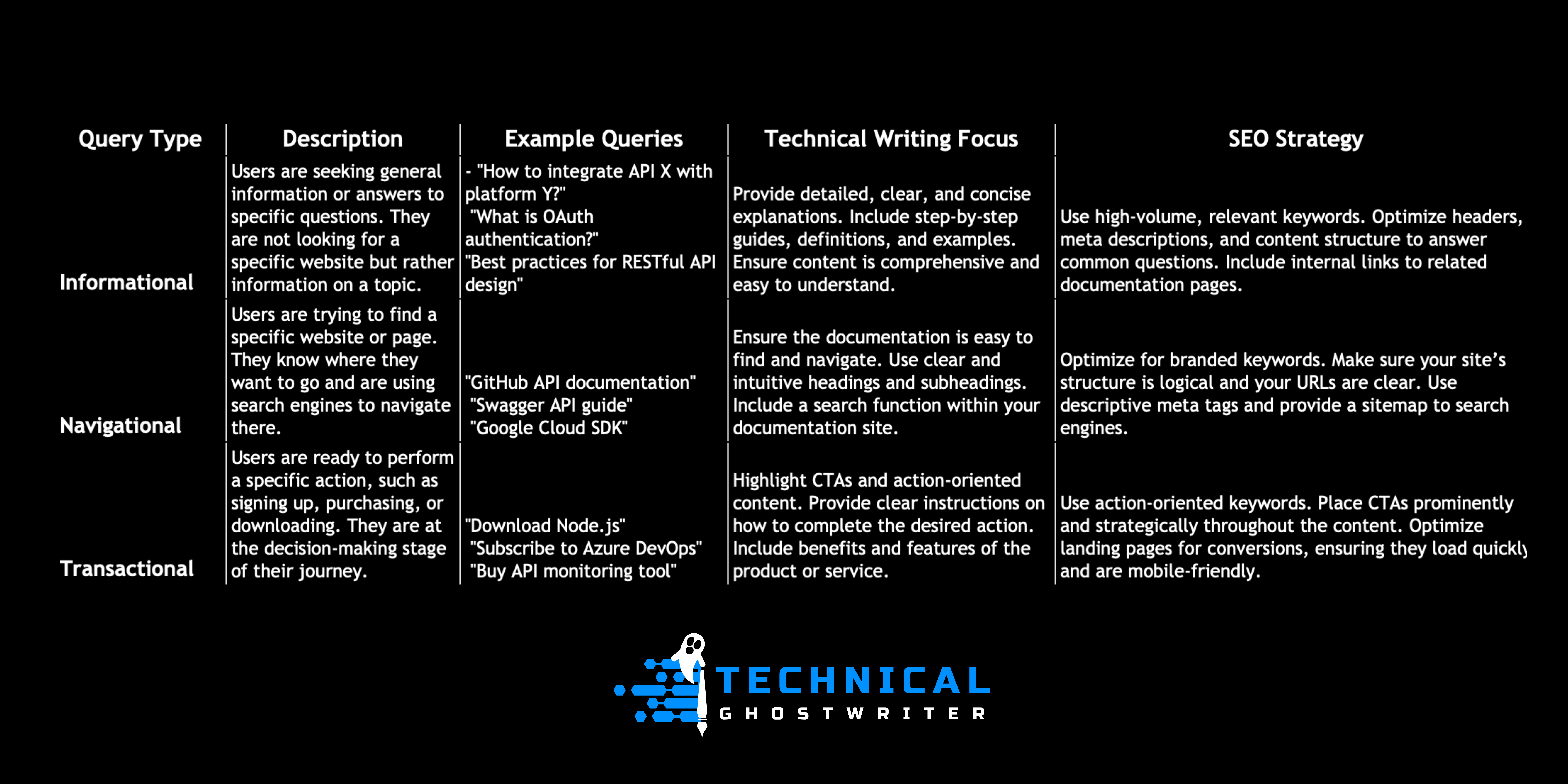Imagine this: you have a SaaS company or a Developer Tool and you want to rank for SEO. You have your amazing Docs written that help developers find everything they need around the product but… you’re not ranking for SEO. Why?
Well, short answer is: you shouldn’t. You can, however, if you do things right.
Get Your Docs Out of the Dark Web and Into the Spotlight!
Your documentation is probably amazing. It’s thorough, it’s precise, and it’s essential for your users. But there’s one problem: it’s buried deep in the search results, lost in the vast sea of the internet. Maybe ranks 70th, 80th, or doesn’t rank at all. To reach a wider audience and maximize its potential, you need your documentation to rank for SEO.
The answer to this challenge? Adapting your content to fit informational queries while skillfully guiding users deeper into your funnel where the real product information lies.
This article will walk you through the steps to tweak your technical documentation, boost your SEO, and turn your docs into a powerful tool for both discovery and conversion.
Of course, if you’d rather have someone else do it, let me know, as this is precisely what a technical ghostwriter does.
Understanding the SEO Landscape
SEO Basics: Keywords, Search Intent, and Ranking Factors
To start, let’s get a grip on the basics of SEO, that you may or may not know. If you do know it, you can safely skip this part.
Think of SEO as the compiler for your documentation’s success. It translates your content into a language that search engines understand and rank highly. There are several basic SEO concepts you should know:
- Keywords: The terms and phrases users type into search engines. These are the building blocks of SEO. You probably searched for something like “how to adapt technical documentation for SEO” or “Docs Expansion Writer” or some other thing related to what I’m explaining to land on this very page.
- Search Intent: Understanding what users are really looking for when they enter a query. In this case, you probably wanted information. This would mean that the keyword, whatever it is that you chose, has an “Informational” intent. On top of this, a keyword can has navigational or transactional intents. You can see the difference between each in the table below.
- Ranking Factors: Elements like page load speed, mobile-friendliness, and backlinks that influence where your content appears in search results. For the sake of this article, we will assume that your website works great, is fast and ranks well for Core Web Vitals.

By understanding and leveraging these components, you can transform your technical documentation into an SEO-friendly powerhouse.
Informational Queries: What They Are and Why They Matter
Informational queries are the questions users ask when they’re looking for information rather than a specific website. These queries often start with words like “how,” “what,” or “why.” For example, a developer might search for “how to integrate API X with platform Y.”
Why do they matter? Because these queries represent a massive opportunity to attract users to your documentation. By aligning your content with these questions, you can capture a broader audience and guide them towards your product. However, you need to understand and remember one thing: Google does not want to give product-related information (transactional or navigational) for informational queries (psst, this is what Adwords Ads are for, you think for yourself). That’s why, for your docs to rank, they need to get surrounded by specific, many times neutral information that will tell the user how to accomplish something in a variety of ways beyond your product docs.
Still with me? Remember that:
The Developer’s Perspective: Think Like a Coder; Write for a Search Engine as well
As a technical writer, you already know how to think like a developer. Now, you need to write for a search engine as well as for the user. Do not write for the search engine only, the magic is combining both.
By blending your technical expertise with SEO strategies, you can ensure that your documentation not only serves its primary purpose but also reaches and resonates with a larger audience. Be careful, as if the content of your docs is too specific, you may want to drift away from docs and add another section, for example, guides, where a specific (neutral) information is found.
Step 1: Keyword Research
Tools and Techniques: Using Ahrefs or SEMrush
Keyword research is your first step in optimizing your documentation for SEO. It’s like setting up your development environment – get it right, and everything else will follow smoothly.
- Ahrefs: This tool helps you discover keywords your competitors are ranking for and provides insights into search volume and difficulty.
- SEMrush: Use this to find keyword ideas and analyze your site’s performance.
Both of these tools can provide you with mostly the same information, and there is an ongoing SEO dispute which one is better. I have and use them both, mostly to compare the data, but the truth is, you will be fine with either of them.
Identify High-Volume, Low-Competition Keywords
When selecting keywords, aim for those with high search volume but low competition. These “long-tail” keywords are more specific and less competitive, making it easier to rank highly.
Practical Tips:
- Brainstorm Keywords: Start with a list of potential keywords related to your documentation.
- Analyze Competitors: See what keywords competitors are using and where there’s a gap you can fill.
- Prioritize: Focus on keywords that are directly relevant to your documentation and product.
By carefully choosing and implementing the right keywords, you set a strong foundation for your SEO strategy, ensuring your documentation reaches those who need it most.
Step 2: Content Optimization
On-Page SEO: Headers, Meta Descriptions, and Keyword Placement
On-page SEO is about fine-tuning your documentation so search engines can easily index and understand it. Think of it as optimizing your code for better performance.
- Headers (H1, H2, H3): Use headers to structure your content logically. Your main title should be an H1, with subsections using H2 and H3 tags. Include keywords naturally within these headers.
- Meta Descriptions: These are the snippets that appear in search results. Craft concise, compelling meta descriptions that include your primary keywords.
- Keyword Placement: Integrate keywords naturally throughout your text. Avoid keyword stuffing; instead, aim for a seamless blend of keywords and informative content.
Optimize your H1 tags like you optimize your functions—clear, precise, and relevant.
Internal Linking: Seamlessly Integrate Links to Deeper Documentation
Internal linking is your way of guiding users through your documentation. Think of it like using pointers in programming to navigate through data structures.
- Anchor Text: Use descriptive anchor text for your links. Instead of “click here,” use “learn more about API integration.”
- Link Depth: Ensure that important pages are easily accessible. Deep-link to detailed documentation pages to keep users engaged.
- User Flow: Design your links to create a logical flow, leading users from general information to specific, detailed content.
Use links like pointers, guiding users to the next piece of information they need.
Step 3: Structuring Your Documentation
Scannable Content: Bullet Points, Numbered Lists, and Concise Paragraphs
Your readers are busy; they scan rather than read in-depth. Make your content scannable to help them find what they need quickly.
- Bullet Points and Numbered Lists: Break down complex information into bite-sized chunks.
- Short Paragraphs: Keep paragraphs brief. Aim for 2-3 sentences to enhance readability.
- Clear Subheadings: Use subheadings to divide sections clearly, helping users navigate the content.
Your readers are debugging; make it easy to find the errors quickly.
Visual Aids: Infographics, Charts, and Code Snippets
Visual aids enhance understanding and retention. Think of them as the syntax highlighting of your documentation.
- Infographics: Summarize complex processes or data visually.
- Charts and Graphs: Use these to present data clearly.
- Code Snippets: Include examples that users can easily copy and implement.
Visuals are your documentation’s syntax highlighting—they make everything clearer.
Step 4: Enhancing Readability
Simple Language: Avoid Jargon; Write in Plain English
Technical documentation doesn’t have to be convoluted. Write in plain, straightforward language.
- Avoid Jargon: Use simple terms where possible. If technical terms are necessary, explain them.
- Clear Instructions: Provide step-by-step instructions in a logical order.
- User-Centric Language: Write with the user in mind, focusing on their needs and perspective.
Write code that even a junior dev can understand—apply the same principle to your docs.
Active Voice: Direct, Dynamic Language to Keep Users Engaged
Using active voice makes your documentation more engaging and easier to follow.
- Direct Sentences: “You can configure the settings” instead of “The settings can be configured by you.”
- Dynamic Language: Use verbs that convey action and encourage users to take steps.
Command your sentences like you command your scripts—keep them active and dynamic.
Step 5: Call to Action (CTA)
Strategic Placement: CTAs to Guide Users Deeper into Your Documentation
CTAs are crucial for guiding users deeper into your documentation and towards conversion points.
- Above the Fold: Place important CTAs where they are immediately visible.
- Within Content: Include CTAs within the body to guide users naturally.
- End of Sections: Place CTAs at the end of sections to lead users to the next logical step.
Like a well-placed breakpoint, guide users to the next step in their journey.
Engaging CTAs: Phrases That Compel Action Without Being Pushy
Craft CTAs that encourage action without sounding forceful.
- Action-Oriented: Use verbs that inspire action, like “Explore,” “Discover,” or “Learn More.”
- Clear and Concise: Keep CTAs short and to the point.
- Relevant: Ensure CTAs are relevant to the content they accompany.
Dive deeper into the docs; unleash the full power of our API.
Step 6: Monitoring and Iterating
Analytics Tools: Google Analytics, Search Console, and Other SEO Tools
Monitoring your SEO performance is essential. Use analytics tools to track your progress and make data-driven decisions.
- Google Analytics: Track user behavior, traffic sources, and page performance.
- Search Console: Monitor your search traffic and identify issues.
- SEO Tools: Use tools like Ahrefs or SEMrush to analyze keyword performance and backlink profiles.
Track your SEO performance like you track your application’s performance—analyze, iterate, and improve.
Feedback Loop: Regularly Update and Refine Your Documentation Based on Data
SEO is an ongoing process. Regularly update your documentation based on analytics and user feedback.
- User Feedback: Collect and analyze user feedback to identify areas for improvement.
- Regular Updates: Keep your documentation current with the latest information and SEO best practices.
- Iterative Improvements: Continuously refine and enhance your content to maintain and improve rankings.
Iterate on your docs like you iterate on your code—keep improving to stay ahead.
Conclusion
By following these steps: keyword research, content optimization, structuring, enhancing readability, strategic CTAs, and ongoing monitoring—you can transform your technical documentation into an SEO powerhouse. With your documentation now optimized for SEO, you’re ready to attract more users and guide them deeper into your product’s offerings. Keep optimizing, and watch your rankings soar.
SEO is like maintaining a codebase – it’s never truly done. Stay agile, keep learning, and continuously adapt to new trends and algorithms.

